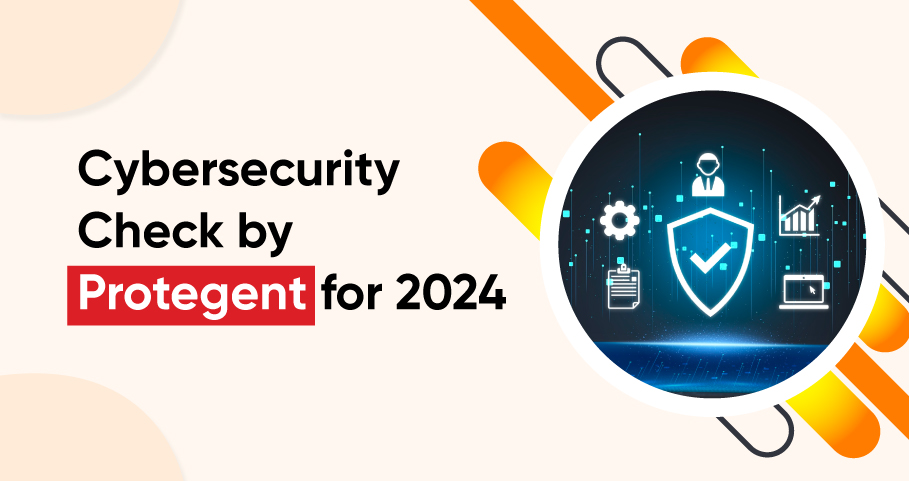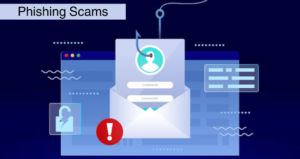
Beware! Scams That Could Target You in 2024
As we step into the New Year, the digital landscape continues to evolve, bringing with it not only technological advancements but also new challenges. Unfortunately, one persistent challenge that individuals need to remain vigilant about is the threat of scams. In 2024, scammers are expected to employ more sophisticated tactics to deceive and exploit unsuspecting individuals. With the increasing reliance on technology and the ever-changing landscape of online interactions, it’s more important than ever to be aware of the latest scams and how to protect yourself in the coming year.
In this blog post we’ll discuss some of the most common scams that have taken place with their case studies, as they are expected to continue to haunt and target people in 2024:
- Deepfake ScamsAssume that a phony video of your supervisor requesting a substantial payment transfer has been made. It could be difficult to discern that this video is phony because it seems so real. This is the nature of deepfakes.Artificial intelligence is used in deepfakes, or synthetic movies and audio recordings, to make individuals appear and sound as though they are saying or doing things they never would. Deepfakes are a tactic used by cybercriminals to fool victims into sending them money or private information.
Case Study:
- In November 2023, a deepfake of the Tesla and SpaceX CEO was used to advertise a cryptocurrency hoax. Before it was removed from social media, the deepfake video, which featured Musk praising a fictitious cryptocurrency named “Elon Coin,” was extensively circulated. The event brought to light how deepfakes may be used to trick investors and influence markets.
- In October 2023, a deepfake video of the Indian star Rashmika Mandanna gained widespread attention on social media. It was eventually discovered that the film, which gave the impression of seeing Mandanna in intimate moments, was fake and made using artificial intelligence.

- Phishing Scams
Phishing efforts, which try to trick you into divulging personal information like credit card details, passwords, or social security numbers, are still the most popular and widely used online frauds. Usually, these frauds appear as texts or emails purporting to be from reputable companies, such as banks, governments, or online retailers.
To guard against phishing scams, use caution while replying to unsolicited emails or messages that request personal information. It’s best to get confirmation from the sender by phone or email before downloading attachments or clicking links. Additionally, never give out personal information via phone or email unless you started the conversation and are certain of the recipient’s validity.
Case Study:
2023 saw the theft of millions of dollars worth of personal information due to a phishing campaign that preyed on Amazon users. The fraud utilized emails posing as Amazon emails to notify victims of unauthorized transactions made to their accounts. The victims clicked on a link in the email and unintentionally entered their login information on a fake Amazon login page.
This case study highlights how important it is to carefully check the sender’s information and proofread the email text for grammar errors. Additionally, links have the genuine destination URL shown when you hover your cursor over them, allowing you to verify their legitimacy before clicking.

- Malware Attacks:
The term malware refers to software designed to steal data and harm your computer system. Malicious software may be installed by several methods, including downloading pirated software, opening infected attachments, and clicking on malicious URLs.
Download software only from reliable sources, use antivirus software, stay away from dubious links, and don’t open unusual attachments if you want to protect yourself from malware assaults. Make sure your free antivirus and anti-malware programs are updated and performing routine scans as well.
Case Study:
Several businesses were affected by the notorious REvil ransomware assault in 2021, notably JBS, the biggest meat producer in the world. The hack entailed breaking into the business’s servers, encrypting its data, and requesting an $11 million ransom to unlock the key.
The significance of implementing cybersecurity measures, such as frequent backups, network segmentation, and staff training on spotting and reporting unusual behavior, is emphasized in this case study. Companies should also think about putting in place a zero-trust security strategy, which necessitates constant user identification and access privilege verification.

- Social Engineering Scams:
Social engineering scams involve tricking victims into giving up personal information or money by manipulating their emotions or sense of trust. Scammers often use social media, dating apps, and online marketplaces to target their victims.
Here are some tips to avoid social engineering scams:
- Don’t share personal information online.
- Do not befriend or accept friendship requests from strangers.
- Be wary of anyone who asks you for money or personal information online.
Case Study:
A social engineering scheme that targeted cryptocurrency investors in 2022 saw over $500 million stolen. The fraud entailed contacting investors under the pretense of being employees of Bitcoin exchanges to get their login information.
This case study emphasizes how crucial it is to confirm the legitimacy of people or organizations before giving them access to sensitive accounts or personal information. Make sure that the phone numbers, email addresses, and website URLs you are using correspond to the actual organization’s contact details by checking them again.

- QR Code Scams:
QR codes, those ubiquitous square-shaped barcodes, have become an essential part of our everyday lives. From making payments to accessing menus and websites, QR codes offer a convenient and contactless way to interact with the world around us. Unfortunately, this convenience has also drawn scammers, who are increasingly targeting users with sophisticated QR code scams.
How QR Code Scams Work
There are several ways that scammers can exploit QR codes:
- Tampering with existing QR codes: Scammers can physically replace legitimate QR codes with malicious ones that redirect users to phishing websites. These websites often mimic the look and feel of trusted sites, such as bank login pages or online retailers, to trick users into entering their personal information.
- Creating fake QR codes: Scammers can create fake QR codes that, when scanned, lead users to malicious websites or download malware onto their devices. These websites may try to steal your personal information, infect your device with viruses, or even lock you out of your data and demand a ransom.
- Using social media and messaging platforms: Scammers may spread QR codes through social media posts, messages, or even QR code-based business cards. These codes may appear to offer deals, discounts, or exclusive content, but they ultimately lead to malicious websites or attempts to steal your information.
The Impact of QR Code Scams
QR code scams can have a significant impact on individuals and businesses alike. Among the consequences of these scams for individuals are:
- Financial loss: Scammers can use stolen personal information to drain bank accounts, make unauthorized purchases, or even commit identity theft.
- Data breaches: Malicious websites accessed through QR codes can steal sensitive information, such as passwords, credit card numbers, and social security numbers.
- Malware infections: Downloaded malware can compromise your device, steal your data, or even spy on your activities.

- Investment Scams:
Investment scams are a pervasive and costly form of financial fraud, targeting individuals and organizations alike. These scams exploit the desire for financial security and growth, often promising unrealistic returns and using manipulative tactics to deceive victims. Understanding how these scams work is crucial to protecting ourselves and others from falling prey to such deceitful schemes.
Today, scammers utilize sophisticated techniques to target victims online through:
- Phishing emails and websites: These scams impersonate legitimate financial institutions or investment firms, luring victims into providing personal information or investing in fraudulent schemes.
- Social media platforms: Scammers exploit social media to spread false investment opportunities and manipulate users through fake profiles and testimonials.
- Unregulated online platforms: Cryptocurrency and binary options trading platforms often lack regulatory oversight, creating fertile ground for fraudulent activities.
- Pump-and-dump schemes: Scammers artificially inflate the price of a particular stock or asset through coordinated buying activity before selling their holdings at a profit, leaving unsuspecting investors with significant losses.

- Tech Support Scams:
A deceptive tech support scam unfolds when a pop-up warns of a virus infection, urging the user to call a provided number for assistance. Upon calling, a purported tech support agent gains remote access to the victim’s computer, instilling a false sense of security. Despite appearing knowledgeable, the scammer exploits this trust by executing commands and installing software, ostensibly eliminating the claimed infection. However, upon restarting the computer, the victim discovers missing files and increased sluggishness, realizing they have fallen victim to fraudsters. Tech support scams often target less tech-savvy individuals, utilizing various tactics such as forging caller IDs or inducing panic to appear legitimate. This cautionary tale underscores the importance of vigilance in the face of evolving cyber threats.
Typical Tech Support Fraud Techniques:
Cold Calls: Fraudsters may contact people without their consent, posing as representatives of a reputable IT business and informing them of a virus or other problem with their computer.
Pop-up Ads: Cybercriminals can place pop-up advertisements on websites, alerting users to possible security risks and urging them to contact a tech support number for prompt help.
Email scams: Con artists might send emails that seem authentic, alerting the recipient to unusual activity on their account and advising them to get in touch with tech support for confirmation.
Avoid falling for unsolicited calls, emails, or pop-up advertising that purports to provide tech assistance if you want to safeguard yourself against tech support scams. Never give someone remote access to your computer unless you made the first contact and are confident in the sender’s identity. Hang up the phone the moment you get an unwanted call from someone posing as a tech support representative, and get in touch with them directly using their official details.
Case Study:
A tech support scam that preyed on senior citizens in 2021 resulted in millions of dollars being stolen. The con artists persuaded the victims to give them remote access to their computers under the guise of Microsoft personnel, which allowed them to steal financial data and install malware.
This case study emphasizes how important it is to warn people about the dangers of tech support scams, especially those who might not be as computer-savvy. It is important to stress that respectable tech firms would never request personal information or remote access to your computer over the phone or in unsolicited emails. Don’t forget that too-good-to-be-true offers are usually false. It is always advisable to err on the side of caution and use total security when it comes to cybersecurity and safeguard yourself from potential scams.

- Fake Charity Scams:
While surfing social media, you stumble upon an endearing message about a young person in need of medical attention. You are inspired to lend a hand right away when you see the post’s link to a contribution page. Without hesitation, you make a sizeable financial donation.
Regretfully, the charity you gave to is a scam. The child’s narrative is false, and the funds you contribute will never be used to help people in need. Rather, it will enrich hackers who take advantage of people’s kindness.
A rising issue is phony charity fraud, which may be quite convincing. To convey a feeling of urgency and make their requests seem more genuine, scammers frequently utilize stolen photos and narratives. Additionally, they could target particular demographics, including the elderly or those who have a history of charitable giving.
To safeguard yourself from these security frauds, be aware of these warning signs:
- Put pressure on you to give right away: Reputable organizations will not pressure you into giving since they recognize that giving is a personal choice.
- Ask for unconventional payment methods: Reputable organizations usually take donations via well-known channels like bank transfers, credit card purchases, or internet payment gateways. Proceed with caution if a charity requests contributions through gift cards, wire transfers, or cryptocurrencies.
- Lack of transparency: Reputable charities need to be able to quickly and easily offer details about their goals, initiatives, and financial situation. Examine a charity closely if this information is absent from its messages or website.
- Make implausible promises: Rather than offering ostentatious prizes for donations, charities should concentrate on having a good influence. Be wary of charities who promise to reimburse you for your donation or investment.
Verify Before You Donate
Spend some time checking the validity of a charity before opening your wallet. Make use of reliable resources to learn about the history, financial standing, and effect of the organization, such as Give.org, CharityWatch, or organization Navigator. Additionally, find out if the charity is registered with the relevant state or national authorities.

Conclusion
The methods fraudsters use to deceive us are becoming more sophisticated as technology advances and the internet expands. These blog post frauds are only a handful of the numerous ways con artists attempt to obtain our money, private information, and feelings.
Knowing the typical red flags and tricks that con artists do is the greatest defense against fraud. It is most often not true what seems too good to be true. Any unsolicited offers or demands for personal information should be handled with caution.
Inform the relevant authorities if you believe you are the victim of fraud. Additionally, you may assist others by endorsing initiatives to raise awareness and funding institutions that provide cybersecurity education.
Recall that you have the information and resources you need to defend yourself. You may safeguard your online presence and lessen the effect of these frauds by being aware of the latest developments, using antivirus software, and adopting proactive strategies.




